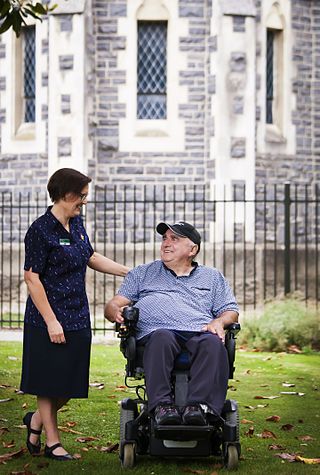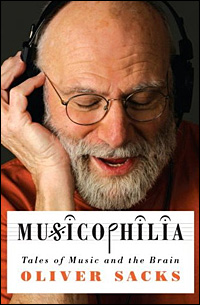Related Research Articles

Dementia is the general name for a decline in cognitive abilities that impacts a person's ability to perform everyday activities. This typically involves problems with memory, thinking, and behavior. Aside from memory impairment and a disruption in thought patterns, the most common symptoms include emotional problems, difficulties with language, and decreased motivation. The symptoms may be described as occurring in a continuum over several stages. Dementia ultimately has a significant effect on the individual, caregivers, and on social relationships in general. A diagnosis of dementia requires the observation of a change from a person's usual mental functioning and a greater cognitive decline than what is caused by normal aging.
Delirium is a specific state of acute confusion attributable to the direct physiological consequence of a medical condition, effects of a psychoactive substance, or multiple causes, which usually develops over the course of hours to days. As a syndrome, delirium presents with disturbances in attention, awareness, and higher-order cognition. People with delirium may experience other neuropsychiatric disturbances, including changes in psychomotor activity, disrupted sleep-wake cycle, emotional disturbances, disturbances of consciousness, or, altered state of consciousness, as well as perceptual disturbances, although these features are not required for diagnosis.

Occupational therapy (OT) is a healthcare profession that involves the use of assessment and intervention to develop, recover, or maintain the meaningful activities, or occupations, of individuals, groups, or communities. The field of OT consists of health care practitioners trained and educated to improve mental and physical performance. Occupational therapists specialize in teaching, educating, and supporting participation in any activity that occupies an individual's time. It is an independent health profession sometimes categorized as an allied health profession and consists of occupational therapists (OTs) and occupational therapy assistants (OTAs). While OTs and OTAs have different roles, they both work with people who want to improve their mental and or physical health, disabilities, injuries, or impairments.
The expressive therapies are the use of the creative arts as a form of therapy, including the distinct disciplines expressive arts therapy and the creative arts therapies. The expressive therapies are based on the assumption that people can heal through the various forms of creative expression. Expressive therapists share the belief that through creative expression and the tapping of the imagination, people can examine their body, feelings, emotions, and thought process.

Art therapy is a distinct discipline that incorporates creative methods of expression through visual art media. Art therapy, as a creative arts therapy profession, originated in the fields of art and psychotherapy and may vary in definition. Art therapy encourages creative expression through painting, drawing, or modelling. It may work by providing a person with a safe space to express their feelings and allow them to feel more in control over their life.
Reminiscence is the act of recollecting past experiences or events. An example of the typical use of reminiscence is when people share their personal stories with others or allows other people to live vicariously through stories of family, friends, and acquaintances while gaining an authentic meaningful relationship with the people. An example of reminiscence may be grandparents remembering past events with friends or their grandchildren, sharing their individual experience of what the past was like.

A caregiver, carer or support worker is a paid or unpaid person who helps an individual with activities of daily living. Caregivers who are members of a care recipient's family or social network, and who may have no specific professional training, are often described as informal caregivers. Caregivers most commonly assist with impairments related to old age, disability, a disease, or a mental disorder.
Mild cognitive impairment (MCI) is a neurocognitive disorder which involves cognitive impairments beyond those expected based on an individual's age and education but which are not significant enough to interfere with instrumental activities of daily living. MCI may occur as a transitional stage between normal aging and dementia, especially Alzheimer's disease. It includes both memory and non-memory impairments. The cause of the disorder remains unclear, as well as both its prevention and treatment, with some 50 percent of people diagnosed with it going on to develop Alzheimer's disease within five years. The diagnosis can also serve as an early indicator for other types of dementia, although MCI may remain stable or even remit.

Reminiscence therapy is used to counsel and support older people, and is an intervention technique with brain-injured patients and those who appear to have "Alzheimer's and other forms of cognitive disease."

In 2007, neurologist Oliver Sacks released his book Musicophilia: Tales of Music and the Brain in which he explores a range of psychological and physiological ailments and their intriguing connections to music. It is broken down into four parts, each with a distinctive theme; part one titled Haunted by Music examines mysterious onsets of musicality and musicophilia. Part two A Range of Musicality looks at musical oddities musical synesthesia. Parts three and four are titled Memory, Movement, and Music and Emotions, Identity, and Music respectively. Each part has between six and eight chapters, each of which is in turn dedicated to a particular case study that fit the overarching theme of the section. Presenting the book in this fashion makes the reading a little disjointed if one is doing so cover to cover, however, it also means one may pick up the book and flip to any chapter for a quick read without losing any context. Four case studies from the book are featured in the NOVA program Musical Minds aired on June 30, 2009.
Psychological therapies for dementia are starting to gain some momentum. Improved clinical assessment in early stages of Alzheimer's disease and other forms of dementia, increased cognitive stimulation of the elderly, and the prescription of drugs to slow cognitive decline have resulted in increased detection in the early stages. Although the opinions of the medical community are still apprehensive to support cognitive therapies in dementia patients, recent international studies have started to create optimism.
As populations age, caring for people with dementia has become more common. Elderly caregiving may consist of formal care and informal care. Formal care involves the services of community and medical partners, while informal care involves the support of family, friends, and local communities. In most mild-to-medium cases of dementia, the caregiver is a spouse or an adult child. Over a period of time, more professional care in the form of nursing and other supportive care may be required medically, whether at home or in a long-term care facility. There is evidence to show that case management can improve care for individuals with dementia and the experience of their caregivers. Furthermore, case management may reduce overall costs and institutional care in the medium term. Millions of people living in the United States take care of a friend or family member with Alzheimer’s disease or a related dementia.
The Society for the Arts in Dementia Care is a non-profit organisation, with branches in Canada and Australia, dedicated to knowledge dissemination and education that focuses on improving the quality of lives of seniors living with dementia by using the visual and performing arts.
Comic book therapy is a form of art therapy in which those undergoing rehabilitation or those who have already completed rehabilitation express their experiences through personal narratives within a comics format. The combination of text and image enables patients to process their memories and emotions through two different, yet compatible mediums. Comic book therapy can also be used in a psychotherapeutic setting, whereby clients are encouraged to read specific comic books, often surrounding topics similar to their own diagnoses. Clients are encouraged to present their thoughts and feelings they experienced while reading as well as to draw parallels with their own lived experiences based on the events that occur within the books. This is done in an effort to reach a cathartic moment of clarity and understanding of one's own life.
For patients with Alzheimer's disease, music therapy provides a beneficial interaction between a patient and an individualized musical regimen and has been shown to increase cognition and slow the deterioration of memory loss. Music therapy is a clinical and evidence-based intervention that involves music in some capacity and includes both a participant and a music therapist who have completed an accredited music therapy program.
The Hilgos Foundation is a nonprofit organization that supports the ongoing process of artistic creation for people who have different forms of memory impairment such as Alzheimer's disease.

Alive Inside: A Story of Music and Memory is a 2014 American documentary film directed and produced by Michael Rossato-Bennett. The film premiered in the competition category of U.S. Documentary Competition program at the 2014 Sundance Film Festival on January 18, 2014. It won the Audience Award: U.S. Documentary at the festival. The documentary explores diseases that impair neurological function, such as Alzheimer's disease and dementia, and proposes a treatment option that is claimed to improve a patient's quality of life. It discusses that the elderly community are on the decline in social status and that western society neglects old age to idealize youth. It includes a series of interviews with individuals of neurology, geriatrics, and music. The documentary tells the story of patients and their experience with music therapy and creating personalized playlists for elderly patients with dementia and Alzheimer's disease based on their music preferences.
The Institute for Therapy through the Art is a non-profit creative arts therapy organization in Evanston, Illinois, in the United States. It was founded in 1975 by Marilyn Richman, a drama therapist and co-founder of the North American Drama Therapy Association (NADTA), as a division of the Music Institute of Chicago, with the help of Frank Little, the director at the time. In 2015, the ITA's 40th anniversary, ITA became its own independent non-profit organization. ITA provides therapeutical services in art, drama, dance/movement and music therapy.

William Charles Utermohlen was an American figurative artist known for his late-period self-portraits completed after his diagnosis of probable Alzheimer's disease. He was diagnosed in 1995, having had progressive memory loss since 1991. After diagnosis he began a series of self-portraits influenced by both the figurative painter Francis Bacon and cinematographers from the German Expressionism movement. The last of his self-portraits was completed circa 2001, some six years before his death.
Music-evoked autobiographical memories (MEAMs) refer to the recollection of personal experiences or past events that are triggered when hearing music or some musical stimulus. While there is a degree of inter-individual variation in music listening patterns and evoked responses, MEAMs are generally triggered in response to a wide variety of music, often popular or classical genres, and are estimated to occur in the range from one to a few times per day, regardless of formal instrumental practice or music lessons. Consistent with the hallmarks of general autobiographical memories, everyday MEAMs similarly exhibit a recency effect, a reminiscence bump, and childhood amnesia, encoding autobiographical knowledge at several levels of specificity and across several common social and situational contexts. The phenomenon of MEAMs has been widely studied in the fields of psychology, neuroscience, and musicology. In recent years, the subject has garnered significant interest from researchers and the general public alike due to music's capacity to evoke vivid, emotional, and episodically rich autobiographical memories.
References
- ↑ "Alzheimer's Society Canada" . Retrieved 7 August 2010.
- ↑ Dupuis, Sherry; McAiney, Carrie A; Fortune, Darla; Ploeg, Jenny; de Witt, Lorna (2016). "Theoretical foundations guiding culture change: The work of the Partnerships in Dementia Care Alliance". Dementia (London, England). 15 (1): 85–105. doi:10.1177/1471301213518935. ISSN 1471-3012. PMC 4674759 . PMID 24419355.
- ↑ "Dementia numbers in Canada". Alzheimer Society of Canada. Archived from the original on 2024-01-06. Retrieved 2024-01-06.
- ↑ Oliver James (20 December 2008). "The Guardian, Art - the key to unlocking dementia". The Guardian.
- 1 2 3 Schneider, Justine (2018). "The Arts as a Medium for Care and Self-Care in Dementia: Arguments and Evidence". International Journal of Environmental Research and Public Health. 15 (6): 1151. doi: 10.3390/ijerph15061151 . ISSN 1661-7827. PMC 6025004 . PMID 29865188.
- 1 2 "Art and Music". Alzheimer's Association. Archived from the original on January 6, 2024. Retrieved January 6, 2024.
- ↑ Friedberg, Adit; Pasquini, Lorenzo; Diggs, Ryan; Glaubitz, Erika A.; Lopez, Lucia; Illán-Gala, Ignacio; Iaccarino, Leonardo; La Joie, Renaud; Mundada, Nidhi; Knudtson, Marguerite; Neylan, Kyra; Brown, Jesse; Allen, Isabel Elaine; Rankin, Katherine P.; Bonham, Luke W. (2023-04-01). "Prevalence, Timing, and Network Localization of Emergent Visual Creativity in Frontotemporal Dementia". JAMA Neurology. 80 (4): 377–387. doi:10.1001/jamaneurol.2023.0001. ISSN 2168-6149. PMC 9972248 . PMID 36848111.
- ↑ "How a Rare Dementia Transforms Patients Into Artists | UC San Francisco". www.ucsf.edu. 2023-07-13. Retrieved 2024-01-06.
- ↑ "6 ways that art therapy can help people with memory loss | Lesley University". lesley.edu. Archived from the original on 2024-01-06. Retrieved 2024-01-06.
- ↑ "How does color affects one's mood?". Arts Fiesta. 2024-01-10.
{{cite web}}: CS1 maint: url-status (link)